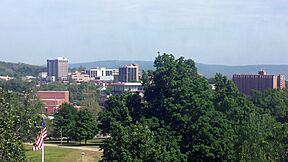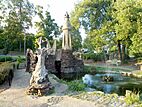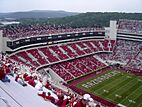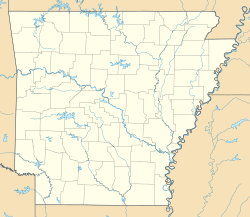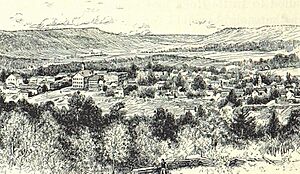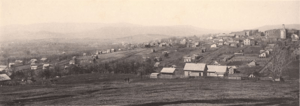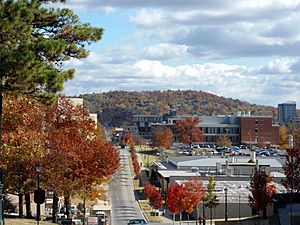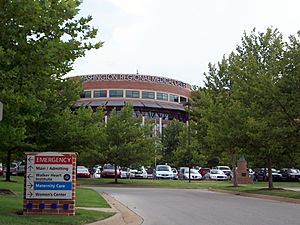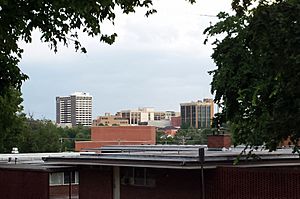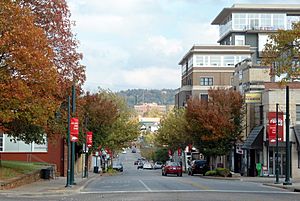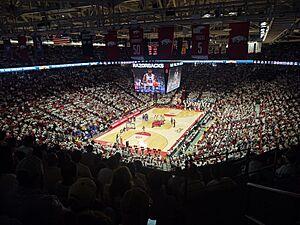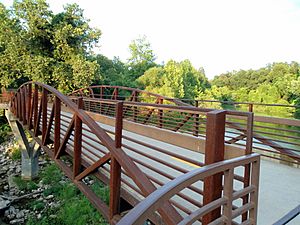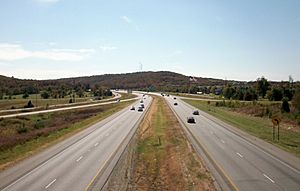Fayetteville, Arkansas facts for kids
Quick facts for kids
Fayetteville, Arkansas
|
|||||
|---|---|---|---|---|---|
|
|
|||||
|
|||||
| Nicknames:
"Track Capital of the World", "The Hill", "Athens of the Ozarks"
|
|||||
| Motto(s):
Regnat Populus (the people rule)
|
|||||
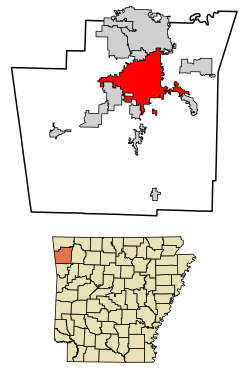
Location of Fayetteville in Washington County, Arkansas.
|
|||||
| Country | |||||
| State | |||||
| County | Washington | ||||
| Township | Fayetteville | ||||
| Founded | 1828 | ||||
| Incorporated | 1836 | ||||
| Rechartered | 1867 | ||||
| Named for | Fayetteville, Tennessee Gilbert du Motier, Marquis de Lafayette | ||||
| Government | |||||
| • Type | Mayor–Council | ||||
| Area | |||||
| • City | 55.80 sq mi (144.53 km2) | ||||
| • Land | 54.42 sq mi (140.96 km2) | ||||
| • Water | 1.38 sq mi (3.57 km2) | ||||
| Elevation | 1,378 ft (420 m) | ||||
| Population
(2020)
|
|||||
| • City | 93,949 | ||||
| • Estimate
(2023)
|
101,680 | ||||
| • Rank | 2nd in Arkansas | ||||
| • Density | 1,726.21/sq mi (666.49/km2) | ||||
| • Urban | 373,687 (US: 111th) | ||||
| • Urban density | 1,884.7/sq mi (727.7/km2) | ||||
| • Metro | 576,403 (US: 98th) | ||||
| Demonym(s) | Fayettevillian | ||||
| Time zone | UTC−6 (Central) | ||||
| • Summer (DST) | UTC−5 (Central) | ||||
| ZIP codes |
72701–72704
|
||||
| Area code(s) | 479 | ||||
| FIPS code | 05-23290 | ||||
| GNIS feature ID | 2403601 | ||||
| Major airport | Northwest Arkansas National Airport (XNA) | ||||
| Rapid transit | Ozark Regional Transit | ||||
| Website | City of Fayetteville | ||||
Fayetteville is the second-largest city in Arkansas. It is the main city in Washington County and the biggest city in Northwest Arkansas. In 2020, about 93,949 people lived here. By 2023, this number grew to an estimated 101,680.
The city is located near the Boston Mountains, which are part of the Ozarks. Fayetteville was named after Fayetteville, Tennessee, because many early settlers came from there. It officially became a town on November 3, 1836. Fayetteville is part of a larger area called the Fayetteville–Springdale–Rogers metropolitan area, which had over 576,403 people in 2020.
Fayetteville is home to the University of Arkansas, which is the state's main university. When school is in session, many students bring a lot of energy to the city. Thousands of Arkansas Razorbacks fans visit Fayetteville to watch exciting football, basketball, and baseball games.
In 2021, Fayetteville became the first city in America to be called a "Bike City" by the Union Cycliste Internationale (UCI). This is because it hosts big cycling events and works hard to improve cycling with special programs and bike paths. The city also hosts the yearly Walmart shareholder meetings at Bud Walton Arena.
Contents
History of Fayetteville
How Fayetteville Began
In 1828, a man named George McGarrah and his family settled near a place called Big Spring. This was the start of a town named Washington. Soon after, Washington County was created, and Washington became its main town.
In 1829, the post office changed the town's name to Fayetteville. This was to avoid confusion with another town called Washington in Arkansas. The name Fayetteville came from Fayetteville, Tennessee. That town was named after General Lafayette, a French general who helped America win the American Revolutionary War.
The first store in Fayetteville was opened by John Nye. Important people like David Walker, a judge, and Archibald Yell, who later became the governor of Arkansas, built homes here. Fayetteville officially became a town on November 3, 1836.
Fayetteville During the Civil War

During the American Civil War, Union soldiers came to Fayetteville in 1862. The city helped wounded soldiers from nearby battles. In April 1863, Confederate soldiers attacked Union troops in Fayetteville. The Union soldiers successfully defended the city.
The building that served as the Union headquarters during the battle is now a museum called the Headquarters House. After the war, two cemeteries were created: the Fayetteville National Cemetery for Union soldiers and the Fayetteville Confederate Cemetery for Confederate soldiers.
Growth After the War
After the Civil War, Fayetteville continued to grow. Newspapers started publishing, like The Arkansan in 1859. The Fayetteville Weekly Democrat began in 1868 and later became the Northwest Arkansas Times, which is still printed today.
The Fayetteville Schools District was created in 1871. It was the first independent school district in Arkansas. Before the war, all schools were private. The first bank in Arkansas, the Stark Bank, opened in Fayetteville in 1872. It later became Arvest Bank.
In 1954, Fayetteville was one of the first cities in the southern United States to end segregation in its schools. This happened after the important Brown v. Board of Education ruling.
Geography and Landscape
What is Fayetteville's Landscape Like?
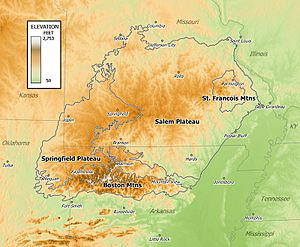
Fayetteville is located in the Boston Mountains. These mountains are part of The Ozarks, which stretch across Arkansas, Missouri, and Oklahoma. The rocks in the Boston Mountains were formed a long time ago from layers of sandstone and shale.
South of Fayetteville, you can see the steep Boston Mountains. To the north, the land is flatter and is called the Springfield Plateau. Fayetteville also gives its name to the Fayetteville Shale, a rock layer where natural gas is found.
Fayetteville's Location and Neighbors
Fayetteville covers about 55.2 square miles. Most of this is land, with a small amount of water. The city is in the middle of Washington County, Arkansas. It is located along Interstate 49 and US Route 71. This major highway helps Fayetteville grow by connecting it to other cities like Fort Smith and Kansas City, Missouri.
To the north, Fayetteville borders Springdale and Johnson. Sometimes, it's hard to tell where one city ends and the next begins. To the south, Fayetteville opens up to beautiful countryside and the Boston Mountains Scenic Loop.
Different Areas of Fayetteville
Fayetteville has different parts, each with its own feel. West Fayetteville is the area west of I-49/US 71. Uptown Fayetteville is in the north, with many businesses and new homes near the Northwest Arkansas Mall.
The University of Arkansas area has many student apartments and restaurants. College Avenue is also full of shops and places to eat. Northeast of campus are the historic Wilson Park Historic District and Mount Nord Historic District.
The Fayetteville Historic Square is the original center of the city. Dickson Street is known as the best place for entertainment in Arkansas. On the east side of the city, homes sit atop Mount Sequoyah. Old roads like Old Wire Road, which was once a stagecoach route, also have historic buildings.
Fayetteville's Climate
Fayetteville has a humid subtropical climate. This means it has all four seasons. It gets cold air from the north, but the Ozark mountains help block some of the coldest air.
July is usually the hottest month, with average high temperatures around 88.7°F (31.5°C). Temperatures above 100°F (38°C) are rare. January is the coldest month, with average low temperatures around 26.9°F (-2.8°C). It can sometimes drop below 0°F (-18°C).
Fayetteville gets rain throughout the year, but it's usually wetter in the spring and fall. May often has the most rainfall.
| Climate data for Fayetteville Experimental Station, Arkansas (1991–2020 normals, extremes 1892–present) | |||||||||||||
|---|---|---|---|---|---|---|---|---|---|---|---|---|---|
| Month | Jan | Feb | Mar | Apr | May | Jun | Jul | Aug | Sep | Oct | Nov | Dec | Year |
| Record high °F (°C) | 76 (24) |
86 (30) |
96 (36) |
96 (36) |
95 (35) |
104 (40) |
111 (44) |
109 (43) |
105 (41) |
96 (36) |
90 (32) |
78 (26) |
111 (44) |
| Mean daily maximum °F (°C) | 46.5 (8.1) |
51.2 (10.7) |
59.1 (15.1) |
69.0 (20.6) |
75.9 (24.4) |
84.1 (28.9) |
88.7 (31.5) |
86.6 (30.3) |
81.4 (27.4) |
70.9 (21.6) |
58.6 (14.8) |
49.6 (9.8) |
68.6 (20.3) |
| Daily mean °F (°C) | 36.7 (2.6) |
40.6 (4.8) |
48.5 (9.2) |
58.1 (14.5) |
66.0 (18.9) |
74.8 (23.8) |
79.1 (26.2) |
78.1 (25.6) |
70.6 (21.4) |
59.4 (15.2) |
48.1 (8.9) |
39.7 (4.3) |
58.3 (14.6) |
| Mean daily minimum °F (°C) | 26.9 (−2.8) |
30.0 (−1.1) |
37.9 (3.3) |
47.2 (8.4) |
56.2 (13.4) |
65.5 (18.6) |
69.4 (20.8) |
67.7 (19.8) |
59.8 (15.4) |
47.9 (8.8) |
37.7 (3.2) |
29.8 (−1.2) |
48.0 (8.9) |
| Record low °F (°C) | −23 (−31) |
−24 (−31) |
−11 (−24) |
18 (−8) |
28 (−2) |
39 (4) |
48 (9) |
44 (7) |
29 (−2) |
17 (−8) |
5 (−15) |
−12 (−24) |
−24 (−31) |
| Average precipitation inches (mm) | 2.57 (65) |
2.31 (59) |
3.74 (95) |
4.51 (115) |
6.01 (153) |
4.68 (119) |
3.59 (91) |
3.44 (87) |
4.53 (115) |
4.05 (103) |
3.99 (101) |
2.86 (73) |
46.28 (1,176) |
| Average precipitation days (≥ 0.01 in) | 6.3 | 6.9 | 7.3 | 8.6 | 11.1 | 8.4 | 7.2 | 7.1 | 7.1 | 7.6 | 6.7 | 6.2 | 90.5 |
| Source: NOAA | |||||||||||||
People and Population
| Historical population | |||
|---|---|---|---|
| Census | Pop. | %± | |
| 1840 | 425 | — | |
| 1850 | 598 | 40.7% | |
| 1860 | 972 | 62.5% | |
| 1870 | 955 | −1.7% | |
| 1880 | 1,788 | 87.2% | |
| 1890 | 2,942 | 64.5% | |
| 1900 | 4,061 | 38.0% | |
| 1910 | 4,471 | 10.1% | |
| 1920 | 5,362 | 19.9% | |
| 1930 | 7,394 | 37.9% | |
| 1940 | 8,212 | 11.1% | |
| 1950 | 17,071 | 107.9% | |
| 1960 | 20,274 | 18.8% | |
| 1970 | 30,729 | 51.6% | |
| 1980 | 36,608 | 19.1% | |
| 1990 | 42,099 | 15.0% | |
| 2000 | 58,047 | 37.9% | |
| 2010 | 73,580 | 26.8% | |
| 2020 | 93,949 | 27.7% | |
| U.S. Decennial Census | |||
Fayetteville is the second-largest city in Arkansas by population.
Fayetteville's Growing Population
| Race / Ethnicity (NH = Non-Hispanic) | Pop 2000 | Pop 2010 | Pop 2020 | % 2000 | % 2010 | % 2020 |
|---|---|---|---|---|---|---|
| White alone (NH) | 48,769 | 59,398 | 69,228 | 84.02% | 80.73% | 73.69% |
| Black or African American alone (NH) | 2,930 | 4,301 | 5,956 | 5.05% | 5.85% | 6.34% |
| Native American or Alaska Native alone (NH) | 685 | 734 | 872 | 1.18% | 1.00% | 0.93% |
| Asian alone (NH) | 1,473 | 2,255 | 2,987 | 2.54% | 3.06% | 3.18% |
| Pacific Islander alone (NH) | 88 | 155 | 469 | 0.15% | 0.21% | 0.50% |
| Other race alone (NH) | 59 | 90 | 348 | 0.10% | 0.12% | 0.37% |
| Mixed race or Multiracial (NH) | 1,222 | 1,922 | 6,007 | 2.11% | 2.61% | 6.39% |
| Hispanic or Latino (any race) | 2,821 | 4,725 | 8,082 | 4.86% | 6.42% | 8.60% |
| Total | 58,047 | 73,580 | 93,949 | 100.00% | 100.00% | 100.00% |
In 2020, Fayetteville had 93,949 residents. There were 36,705 households and 16,703 families living in the city.
The 2010 census showed Fayetteville had 73,580 people. This was a 26.8 percent increase from 2000. The city had 33,661 households. About 19.9% of these households had children under 18.
Fayetteville is known for having many educated people. In 2010, about 40.5% of adults aged 25 or older had a college degree or higher. About 24.6% had a bachelor's degree or more.
The median age in Fayetteville was 27.8 years. This means half the people were younger than 27.8 and half were older. For every 100 females, there were about 100.9 males.
Many people in Fayetteville consider themselves religious. About 69.6% of the population identifies with a religion. The largest group is Baptist, making up about 50.8% of religious people.
Economy and Jobs
| 2020 Rank |
Employer | 2010 Rank |
|---|---|---|
| 1 | University of Arkansas | 1 |
| 2 | Washington Regional Medical Center | 2 |
| 3 | Walmart | 5 |
| 4 | Fayetteville School District | 4 |
| 5 | Veterans Administration Medical | 3 |
| 6 | City of Fayetteville | 6 |
| 7 | APAC Central, Inc. | NR |
| 8 | Pinnacle Foods | NR |
| 9 | Tyson Foods | NR |
| 10 | Washington County Government | 7 |
Fayetteville's economy is strong, with many jobs coming from large companies and the university. Walmart is a huge company based nearby in Bentonville, Arkansas. Tyson Foods is another big company located in Springdale, Arkansas, right next to Fayetteville.
These companies have a big impact on the University of Arkansas. For example, the Sam M. Walton College of Business at the university has received many gifts from the Walton family (who started Walmart). Tyson Foods also supports the university's poultry science program.
The University of Arkansas has become a major center for research. This focus on new ideas and discoveries helps attract students who want to do research. It also helps the economy of the region and the state. In 2011, the university was recognized for its "Highest Research Activity."
In 2011, a company called DataRank started in Fayetteville. It helps businesses understand what people are saying about their brands online. In 2016, Fayetteville announced it wants to become "The Startup City of the South." This means it wants to help more new businesses get started.
Arts and Culture
Fayetteville has a unique culture. It's a mix of a Southern city, a college town, and a fast-growing metropolitan area. Many of the first settlers came from states like Kentucky and Tennessee. They found the Ozarks similar to the Appalachian Mountains where they used to live.
The city's culture is also shaped by the University of Arkansas. Like many college towns, Fayetteville has a lively arts and music scene. People here often support local businesses and care about protecting the environment. There's also a strong passion for college sports, especially for the Arkansas Razorbacks.
Fayetteville has a great BBQ tradition, with many restaurants serving Memphis-style barbecue. You can also find many other types of food, like Thai, Vietnamese, and Cajun. The Fayetteville Roots Festival is a yearly event that celebrates local food and music.
The University of Arkansas: A City Hub
The University of Arkansas is a huge part of Fayetteville. It influences the city's social life, economy, and education. It's the main university in the state. The university's historic campus has many beautiful buildings and green spaces.
In the fall, many parents visit to help their children move into dorms. Thousands more come to watch Razorback football games. Fans also fill Bud Walton Arena for basketball games. In the spring, the baseball team plays at Baum Stadium, which is one of the best college baseball fields.
A special feature on campus is Senior Walk. It's a five-mile sidewalk with the names of every graduate from the University of Arkansas.
Dickson Street: Fun and Entertainment
Dickson Street is the main entertainment area in the region. You can find music, theater shows, shops, and restaurants here. It's right next to the University of Arkansas campus. Many places on Dickson Street are popular with both students and locals.
The Walton Arts Center is on Dickson Street. It's a top place for arts and entertainment in Arkansas. It hosts Broadway shows, art camps, and community events. A large donation from the Walton family helped build this center.
TheatreSquared is a professional theater located near Dickson Street. It puts on shows all year round. George's Majestic Lounge is also on Dickson Street. It's the oldest live music venue in Arkansas. It opened in 1927 and has hosted many concerts.
Fayetteville Square: The Heart of the City
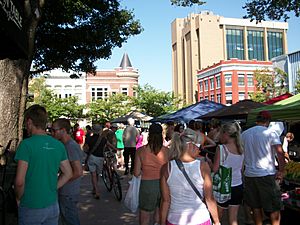
The Fayetteville Historic Square has been the center of Fayetteville since 1829. It has wide sidewalks, gardens, and unique shops. The Square hosts many events, like the Fayetteville Farmer's Market. You can find boutiques, restaurants, museums, and a visitor center here.
The farmers' market started in 1974. It runs from April to November on Saturdays. Over 60 vendors sell fresh fruits, vegetables, crafts, and flowers. The market also accepts food stamps.
The Fayetteville Public Library moved into a new building in 2004. It was the first "green" building in Arkansas, meaning it was built to be good for the environment. The library is very popular and hosts film festivals and book signings.
Historic Places to Visit
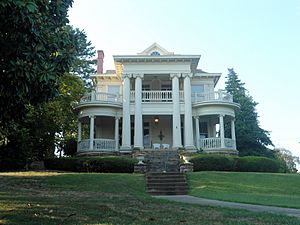
Fayetteville has 40 places listed on the National Register of Historic Places. These are important buildings and sites that are protected. The University of Arkansas Campus Historic District is the historic heart of the university. There are also historic neighborhoods like the Mount Nord Historic District and Wilson Park Historic District.
The Headquarters House was a command post during the Civil War. Today, it's a museum. The Fayetteville National Cemetery is also a historic site. It was built in 1867 after the Civil War.
The house where Bill and Hillary Clinton lived and got married is now the Clinton House Museum. It shows their early political life and has items from their campaigns.
Sports and Recreation
Fayetteville doesn't have professional sports teams. This means the Arkansas Razorbacks are the biggest sports attraction. The Razorbacks are often called "The State of Arkansas's Professional Team." They play in the National Collegiate Athletic Association's top division.
Donald W. Reynolds Razorback Stadium is where the Arkansas Razorbacks football team plays its home games. Bud Walton Arena is home to the men's and women's basketball teams. This arena was built in 1993 and can hold over 19,000 fans. The baseball team plays at Baum Stadium, which is one of the best college baseball fields in the country.
Fayetteville is sometimes called the "Track Capital of the South." This is because of the success of Arkansas's track and cross country teams. The city has hosted major track and field championships at the Randal Tyson Track Center and John McDonnell Field.
The Blessings golf course is a challenging golf course in Fayetteville. It's home to the University of Arkansas Razorbacks golf teams. The 2022 UCI Cyclo-cross World Championships was also held in Fayetteville, showing its commitment to cycling.
Parks and Outdoor Fun
The Fayetteville Parks and Recreation Department takes care of 70 parks. These parks cover a total area of about 3,129 acres. Many of Fayetteville's parks and trails are Certified Wildlife Habitats. This means they provide food, water, and shelter for local wildlife.
Wilson Park is a favorite park in Fayetteville. It was the city's first park. Today, it has a swimming pool, playgrounds, a baseball field, and picnic areas. It also has a castle built in 1981.
The Botanical Garden of the Ozarks is a newer addition to Fayetteville. It's a beautiful garden that is still growing. It includes a visitor center, cafe, and many different gardens.
Fayetteville is proud of its trail system. It has been named a Bicycle Friendly Community since 2010. The trails are well-marked and have signs along the way. The city has trails within its limits and parts of longer trails like the Razorback Regional Greenway. This greenway is a 36-mile paved trail that connects Fayetteville to other nearby cities.
The Scull Creek Trail is a main trail in Fayetteville. It's almost 4 miles long and crosses the creek six times. It also has a 650-foot tunnel, which was once the only pedestrian tunnel in Arkansas. The city plans to add over 100 miles of multi-use trails in the future.
Education in Fayetteville

Most students in Fayetteville attend schools in the Fayetteville Public Schools system. This system has eight elementary schools, four middle schools, and Fayetteville High School. It is the oldest school district in Arkansas, started in 1871. Fayetteville High School has been recognized as one of the best high schools in the South.
Fayetteville is also home to Haas Hall Academy, a public charter high school. It was the first open-enrollment charter high school in Arkansas, founded in 2004. Haas Hall has been named the best school in Arkansas by Newsweek.
The University of Arkansas was founded in Fayetteville in 1871. It is the main campus of the University of Arkansas System. In 2010, over 21,400 students attended the university. While it offers many different degrees, it is especially known for its architecture, history, creative writing, poultry science, and business programs. The university's large presence makes Fayetteville feel like a true college town.
Media and News
Fayetteville has many ways for people to get news and entertainment.
Radio Stations
The University of Arkansas operates two radio stations: KXUA 88.3 FM, run by students, and KUAF 91.3 FM, an National Public Radio station. Other stations play different types of music and news. For example, KKEG 98.3 FM plays classic rock, and KKIX 103.9 FM plays country music. There are also stations for sports news and religious programs.
Local TV Stations
Fayetteville is part of the Fort Smith/Fayetteville television market. This means it shares TV stations with Fort Smith. Some of the local TV stations include:
- KAFT (AETN) 13 - PBS
- KFSM 5 – CBS
- KFTA 24 – Fox
- KHOG 29 – ABC / The CW
- KNWA 51 – NBC
- KXNW 34 – MyNetworkTV
Local Newspapers
You can read local news in Fayetteville through several newspapers:
- Arkansas Democrat-Gazette
- The Morning News
- Northwest Arkansas Democrat Gazette (which includes the Northwest Arkansas Times)
- The Fayetteville Free Weekly
- Washington County Observer
- The University of Arkansas Traveler
Online News
- Fayetteville Flyer is a local online news source.
Transportation and Utilities
Major Roads
The main highway through Fayetteville is Interstate 49/US 71. This four-lane highway helps people travel quickly through the area. It was built in the 1990s to help with the fast growth of the Northwest Arkansas metro area.
Other important roads include US 71B, also known as College Avenue. This road has many restaurants and stores. Arkansas Highway 265 is the oldest road in Fayetteville. It was once used by Native Americans and Civil War troops.
Public Transportation
Fayetteville has two main public transportation services. Razorback Transit is a free bus system that runs around the campus of the University of Arkansas and to other parts of Fayetteville. Ozark Regional Transit is a larger bus system that serves both Washington and Benton Counties.
Airports
Drake Field, which used to be Fayetteville Municipal Airport, is owned by the city. It is used for private planes. For commercial flights, the closest airport is Northwest Arkansas National Airport (XNA). It opened in 1998 and is located about 17 miles northwest of Fayetteville.
Water and Wastewater
The City of Fayetteville has its own water system. It provides drinking water to Fayetteville and other nearby towns. The water comes from a treatment plant in Lowell. The city uses about 16 million gallons of water every day.
Fayetteville also manages its own wastewater system. This includes pipes and treatment plants that clean the water. The city has two main wastewater treatment plants. Fayetteville also has a program that uses treated waste to help fertilize crops.
See also
 In Spanish: Fayetteville (Arkansas) para niños
In Spanish: Fayetteville (Arkansas) para niños


